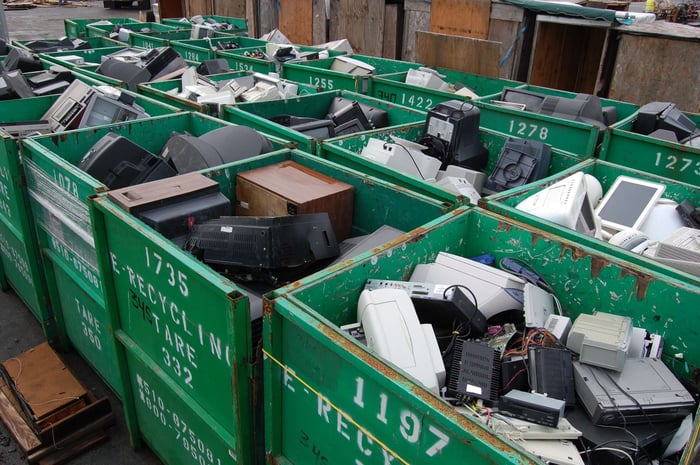Cell phones, computers, toaster ovens, VCRs, stereos- you name it-the impact of electronic waste worldwide is extensive. Let’s look at it on an individual level… there’s the input of raw materials, production, and transportation of making one device. For example, a study identified that producing one computer takes at least 1.5 tons of water, 48 lbs of chemicals, and 530 lbs of fossil fuels. Or there’s that cell phone someone had with a non-functioning battery that ended up in the landfill that contains precious metals such as silver and gold. It all adds up… another study found that Americans throw away approximately $60 million worth of silver and gold per year by tossing old cell phones in the landfill. Beyond the high natural resource use, negative environmental impact, and economic losses of producing many electronics and just tossing them, landfill disposal of e-waste also has the potential to cause harm to human health. Many electronics contain lead and mercury, both of which create human health risks. For example, according to the EPA, if released into the environment, the excessive amount of lead in e-waste, could cause severe damage to human blood and kidneys, and central and peripheral nervous systems.

Here’s a look at e-waste by the numbers:
- 41.8 million tons of e-waste are produced worldwide annually (2014)
- With just over four percent of the world’s population, the United States produces almost thirty percent of the globe’s e-waste, more e-waste than any other country in the world: more than 11.7 million tons annually (2014)
- The amount of global e-waste is projected to grow by 8 percent per year
- Currently, only 15 to 20 percent of all e-waste is recycled
- According to a recent report by the EPA, every day, over 416,000 mobile devices and 142,000 computers are disposed of… which means there is a choice for them to be recycled or disposed of in landfills and incinerators
- Another EPA report states that by recycling one million cell phones, we can recover more than 20,000 lbs of copper, 20 lbs of palladium, 550 lbs of silver, and 50 lbs of gold

Americans now own approximately twenty-four electronic items per household, and approximately one billion cell phones and 300 million computers are put into production annually. While electronics may seem to be made to quickly become obsolete- a cell phone that gets glitches right at the end of your two-year contract, a TV that is soon “old” compared to a newer, thinner, higher quality version, it’s crucial to extend the life of electronics and eventually, go through the proper motions of recycling them. Allison described, “The best way to recycle is to refurbish and keep working toward a circular economy, to fix and use electronics rather than shredding them.” As an example, Allison noted LCD monitor disposal being a huge issue right now in the U.S. because of LCD’s containing mercury. Recycling is a must, but rather than stripping the monitors for raw materials, SMR repairs the monitors and sells them as TVs, giving the products extended lives.
Allison of SMR continued, “We try to give our partners the best return for products, and at the same time consider how to eliminate this issue that a very small percentage of billions of lbs of waste is recycled every year. Pushing the whole sustainability portion gets overlooked sometimes. It’s not just businesses, individuals with household items that they are storing in their closet or throwing away have value.”
So, how do you recycle electronic waste? Many towns have local drop-boxes or annual pick-ups at a set location. Inquiring with your waste management facility or dump should yield information on how to recycle your electronic waste, and if not, a quick internet search should direct you to the closest e-waste recycling facility to you or pick-up schedule.
But- studies recommend that individuals and businesses do not just consider recycling, but rather focus further on reducing the amount of e-waste produced by reducing consumption of electronic items and making those you have, last. Although there is some shift, a large stream of Americans’ e-waste gets shipped overseas, essentially shifted human and environmental risks elsewhere.
Finally, what can you recycle? As the expert Tom Allison put it himself “basically anything with a circuit board or plug”, and also batteries and battery operated electronics and appliances.

What it comes down to is this: we live on a planet of finite resources, and every action for a more sustainable tomorrow counts. In the case of e-waste, it can sometimes be confusing about what to do with it, but by asking around and extending use or disposing properly of items makes a crucial difference.






